If you’re facing the aftermath of a storm that has left your roof damaged by wind and falling trees, you’re likely seeking urgent solutions. This article will guide you through detecting signs of roof storm damage from wind trees, understanding the impact of wind and trees on your roof’s integrity, and steps you can take to recover and prevent future damage efficiently. Whether it’s assessing the damage yourself or knowing when to call professionals like CoMo Premium Exteriors, we’ve got you covered without any fluff.
Key Takeaways
- Regular maintenance and installing wind-resistant materials, such as metal roofing or specially designed shingles, are crucial for protecting your roof against wind and tree damage.
- Visible signs of roof storm damage include missing or damaged shingles, dented gutters and flashing, as well as interior water stains and leaks, which should be addressed promptly to avoid further damage.
- After experiencing storm damage, homeowners should assess the damage safely, contact a professional roofing contractor like CoMo Premium Exteriors, and file an insurance claim to cover repair costs.
Understanding Roof Storm Damage from Wind and Trees
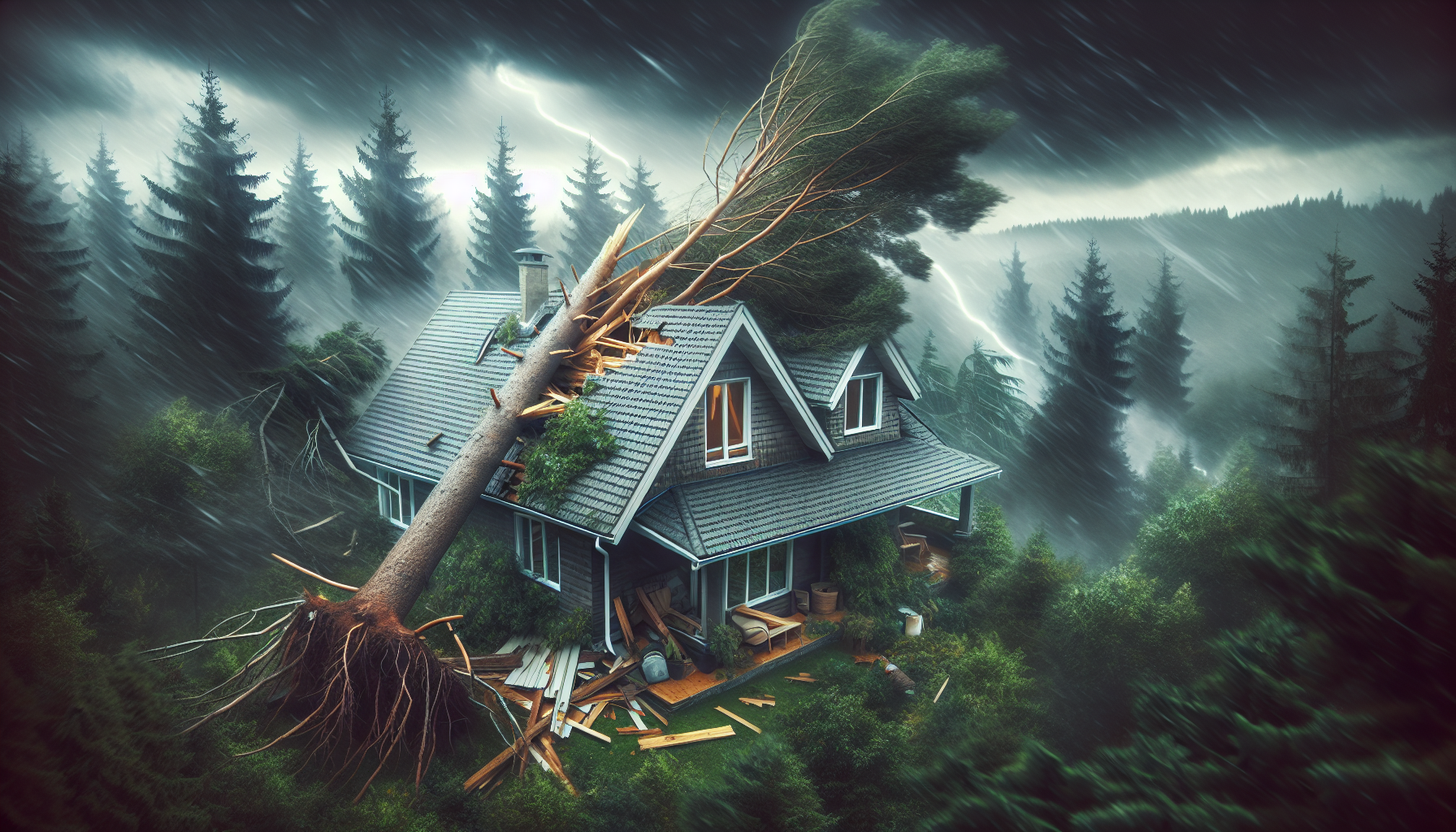
Illustration of wind and trees causing roof storm damage
Storm damage to your roof can occur in many ways, but wind and trees often play a significant role. Grasping the potential risks these factors pose allows for better home protection and effective response when damage happens.
Wind-Induced Roof Damage
Wind can be a formidable adversary for any roof. Shingles, especially those made of asphalt, can be lifted, torn, or curled by high winds, leading to leaks and other structural issues. Wind speeds as low as 45 mph can initiate roof damage, and as speed increases, the severity escalates.
To protect your roof from wind damage, consider the following:
- Install wind-resistant materials, such as impact-resistant shingles or metal roofing.
- Use protective elements, such as plywood or hurricane straps, to reinforce the roof before a storm.
- Regularly inspect and maintain your roof to ensure it is in good condition and can withstand high winds.
By taking these precautions, you can help guard against wind damage and prolong the lifespan of your roof.
However, even with these precautions, there’s no guarantee your roof will remain unscathed after a severe storm, making your roof vulnerable. Hence, having a dependable roofing contractor such as CoMo Premium Exteriors for full roof replacement or required repairs following sustained damage is advisable.
Tree-Related Roof Damage
Trees can add a touch of nature to your property, but they can also pose a threat to your roof. Falling tree branches and debris can puncture or damage the roof, causing:
- leaks
- structural problems
- broken shingle patterns
- holes
- dents
- punctures
If you notice any of these signs, it’s important to address the tree-related roof damage as soon as possible.
Should you suspect tree-related roof damage, it’s advisable to enlist the services of a professional for assessment and resolution of these concerns. At CoMo Premium Exteriors, we’re equipped to handle all types of roof damage with expertise and efficiency, whether it’s from a major storm or a fallen tree limb.
Common Signs of Roof Storm Damage to Watch For
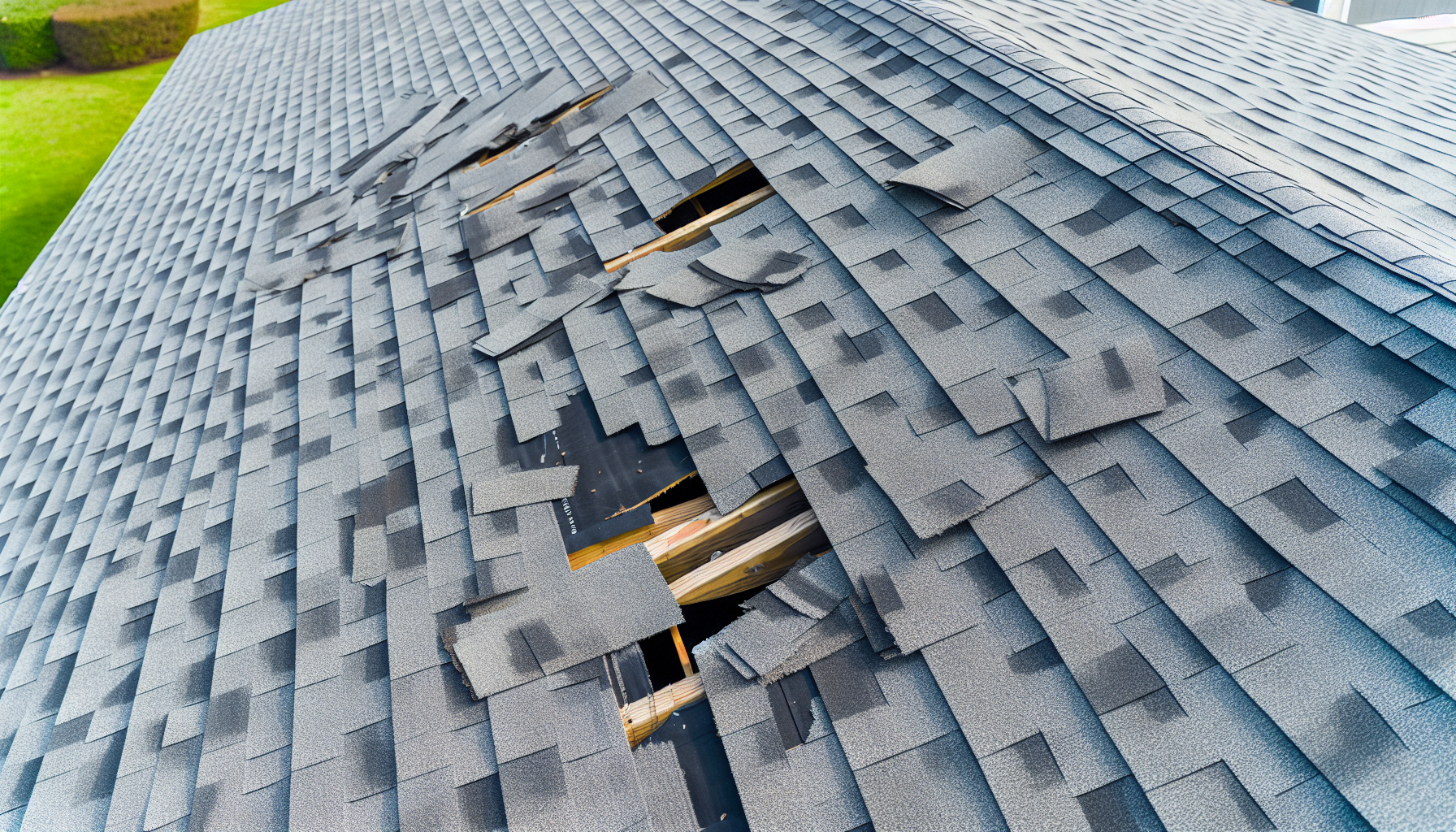
Photo of missing or damaged shingles on a roof
Staying alert for indicators of roof storm damage on your roof’s surface is integral to home maintenance. Recognizing these signs early means you can address potential problems before they turn into costly repairs.
Missing or Damaged Shingles
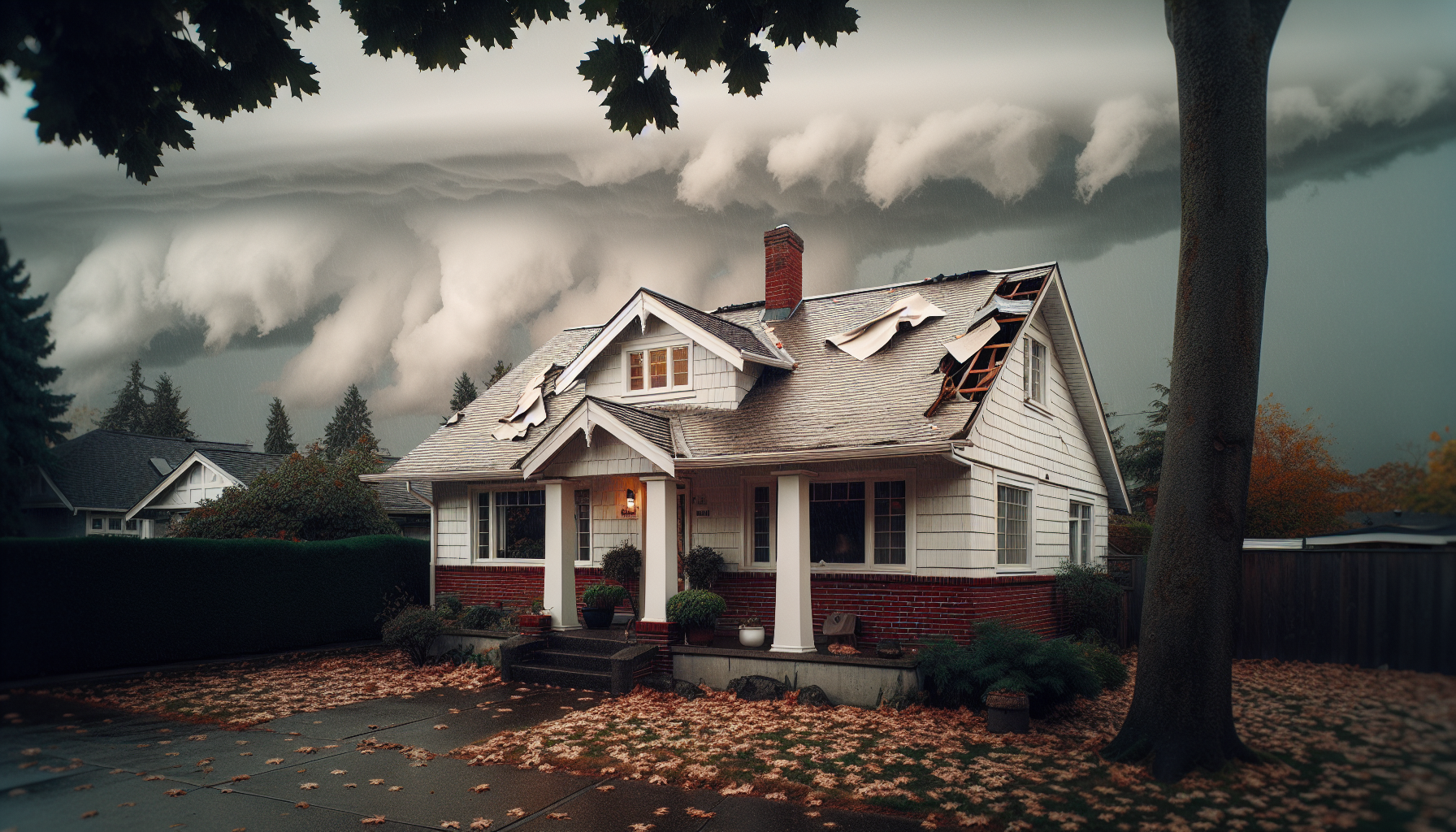
Illustration of dented gutters and flashing on a house
One of the most visible signs of roof damage is missing or damaged shingles. A visual inspection can reveal significant gaps or bare patches where shingles are absent. The loss or damage of shingles during a storm can be attributed to factors such as improper installation, old age, or high winds.
Hence, addressing any missing or damaged shingles promptly can help reduce the risk of further damage. Delaying repairs can result in water damage inside the home, compromised structural integrity of the roof, and heightened risk of pest infestations.
Dented Gutters and Flashing
Hail or debris from a storm can also cause dents in your gutters and flashing. These dents are not just cosmetic issues; they can lead to functional problems with your gutters and flashing, including cracks in slates, breakage of shingles, and indentations on gutters, flashing, and roof vents. Metal flashing is especially vulnerable to hail damage.
If you notice dented gutters or flashing after a storm, reach out to your local roofing company. At CoMo Premium Exteriors, we’re equipped to handle a full roof replacement or repair any hail damage to your gutters and flashing, ensuring your roofing system functions optimally.
Interior Water Stains and Leaks
Interior water stains and leaks are more signs of potential roof damage. These issues can be indicators of more serious problems like structural damage or roof deterioration.
Professional roofing repair addresses interior water stains and leaks through a systematic approach, which involves identifying the source of the issue, inspecting the roof deck, and pinpointing the exact location of the leak for targeted repair. By catching and addressing these issues early, you can prevent more costly and extensive damage down the line.
How to Prevent Roof Storm Damage from Wind and Trees
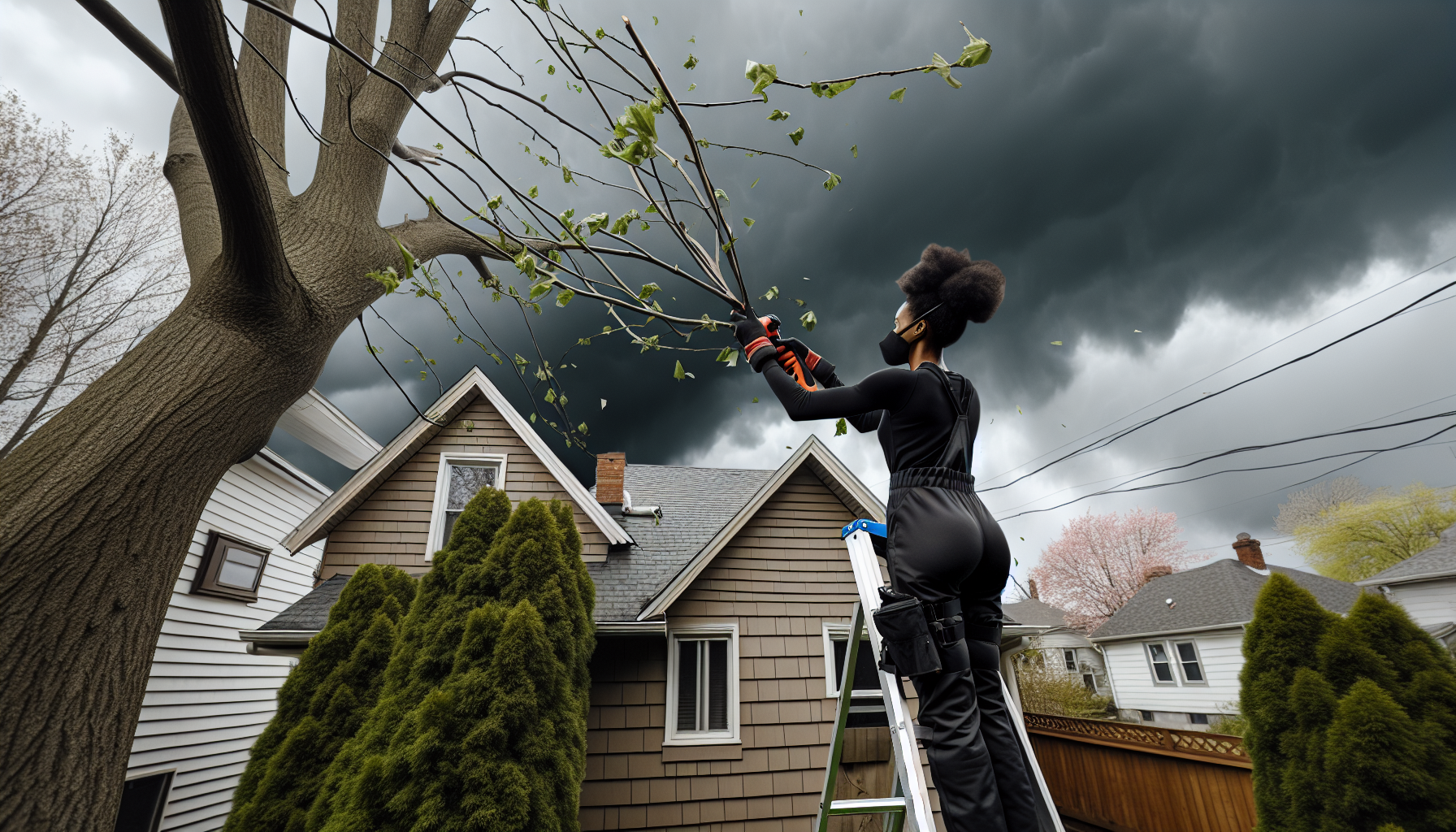
Illustration of roof maintenance and tree trimming
Prevention is always better than cure, especially when it comes to protecting your home from roof storm damage. Routine roof maintenance, pruning overhanging branches, and fitting wind-resistant materials are all key steps in preventing wind and tree-caused damage.
Regular Roof Maintenance
Consistent roof maintenance is a key aspect of home care. It’s recommended to conduct roof maintenance at least twice a year to mitigate the risk of storm damage. Regular roof maintenance can help identify issues such as:
- leaks
- missing or damaged shingles
- excessive condensation
- cracked flashing
- clogged gutters
- moss or algae growth
By addressing these issues promptly, you can prolong the lifespan of your roof and prevent costly repairs in the future.
Not only does regular roof maintenance help prevent significant roof repairs, which can range from $1,500 to $7,000, it results in substantial cost savings in the long run. As a trusted roofing contractor, CoMo Premium Exteriors is ready to provide professional roof maintenance services to help you prevent storm damage.
Trimming Overhanging Branches
Pruning overhanging branches is another vital step in averting roof storm damage. Overhanging branches pose a risk as they can be blown over by wind, causing structural damage.
When trimming overhanging branches to mitigate roof storm damage, consider trimming any dead branches and branches that have grown too close to the roof. It’s also crucial to ensure the cleaning of gutters and downspouts to prevent debris from causing clogs or hindering proper roof drainage.
Installing Wind-Resistant Roofing Materials
For areas susceptible to high winds, fitting wind-resistant materials can offer extra protection for your home. These materials include:
- Galvanized or stainless steel hurricane fasteners
- Fiberglass shingles
- Metal roofing
- Clay tiles
- Owens Corning shingles with SureNail® technology
These materials, including asphalt shingles, are designed to withstand high winds, decreasing the likelihood of shingles being lifted, torn, or damaged in storms.
While wind-resistant materials may cost more upfront than regular roofing materials, their durability and extended lifespan make them a wise investment in the long run.
Steps to Take After Experiencing Roof Storm Damage
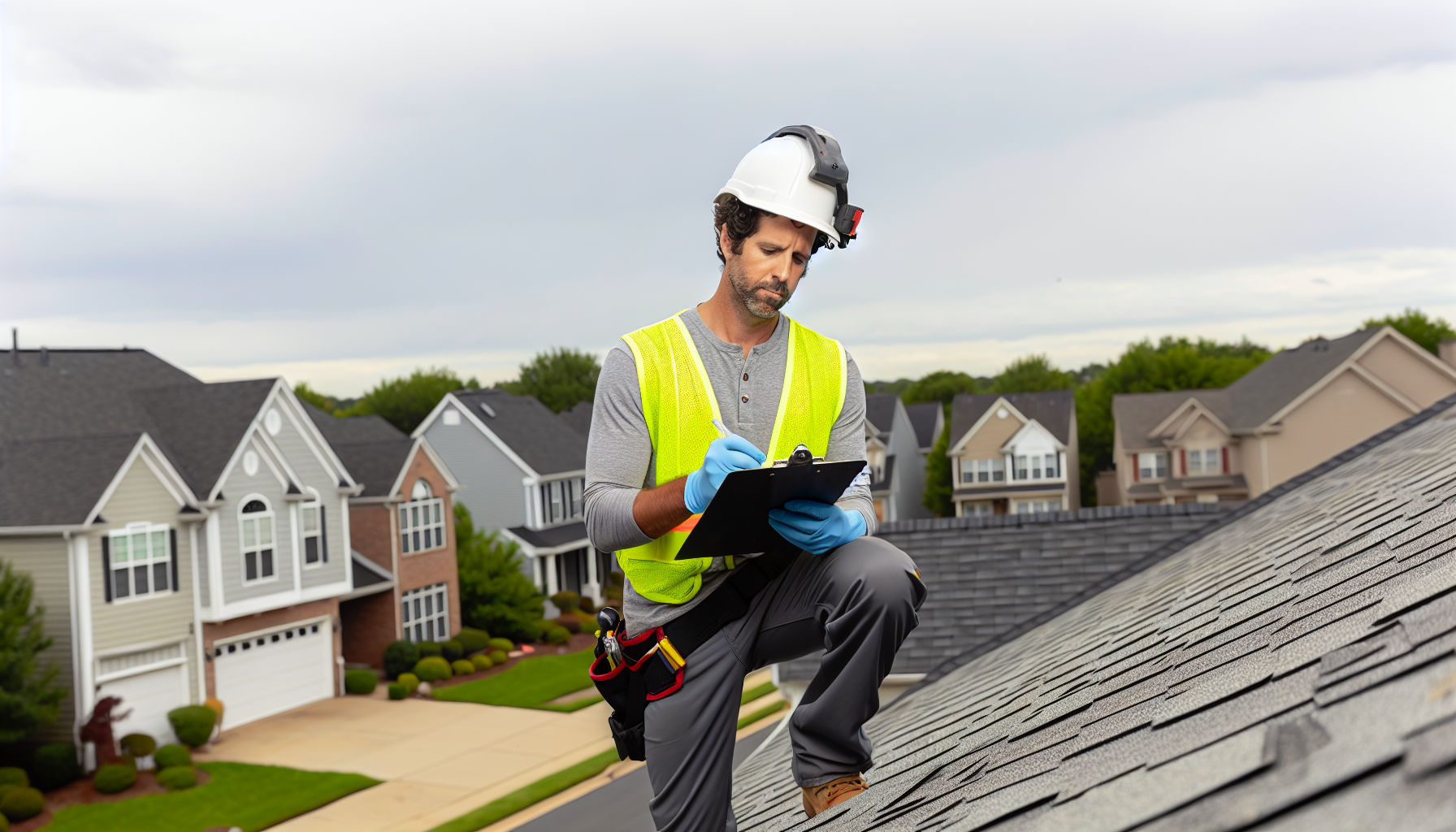
Photo of a professional roofing contractor inspecting storm damage
Experiencing roof storm damage can be stressful, but being aware of the subsequent steps can ease the process. Here’s a roadmap to guide you through assessing the damage, contacting a professional roofing contractor, and filing an insurance claim.
Assess the Damage
Once the storm has subsided and it’s safe to go outside, you can begin to evaluate the damage. Start by conducting a visual assessment to identify roof damage and determine the scope of the damage.
Before you climb up to inspect your roof, remember that safety should always come first. Avoid accessing the roof if it’s unsafe. Instead, assess the damage from a safe distance. Check for fallen branches, trees, or hail dents on decks or patios and inspect the ground for loose shingles, which may indicate roof damage.
Contact a Professional Roofing Contractor
After assessing the damage, the subsequent step is to reach out to a professional roofing contractor. CoMo Premium Exteriors is a trusted roofing contractor that can assist you in dealing with roof storm damage.
When selecting a professional roofing contractor, consider the following:
- Experience
- Licensing and insurance
- Reputation
- Communication skills
- Verified permits and licenses
With CoMo Premium Exteriors, you can be confident that you’re engaging a reliable and professional service that will put your needs first.
File an Insurance Claim
Submitting an insurance claim is a key step in covering the cost of roof storm damage repairs. Start by documenting the damage through photos and contacting your homeowners insurance company to inform them of the situation, ensuring your insurance company covers the necessary expenses.
The approval or denial of an insurance claim for roof storm damage typically takes approximately one to two weeks following the adjuster’s inspection. Upon approval, the insurance settlement may be received within an additional 30 to 60 days.
Choosing CoMo Premium Exteriors for Your Roof Storm Damage Repairs
CoMo Premium Exteriors is a reliable partner for roof storm damage repairs. As a Missouri-based exterior remodeling company specializing in:
- Roofing
- Siding
- Windows
- Deck installation
We offer a range of comprehensive services tailored to address storm damage. We also provide financing options to assist in the management of expenses related to roof storm damage repairs.
We serve clients across Columbia, Moberly MO, and neighboring areas in Mid-Missouri.
Summary
Handling roof storm damage from wind and trees can be a daunting task. However, by understanding the various types of roof storm damage, watching for common signs of damage, taking preventive measures, and knowing what steps to take after experiencing damage, you can navigate this challenging situation effectively. CoMo Premium Exteriors is here to support you through this process, providing professional, licensed, and insured services to assist you in repairing and protecting your home.
Frequently Asked Questions
What does wind damage to a roof look like?
Wind damage to a roof can include loose or missing shingles, chimney problems, curling or peeling shingles, granule loss, damaged soffit or fascia, and indoor leaks, along with possible damage from fallen tree branches. High winds can also lead to granule loss from shingles, similar to hail damage.
Can trees damage roofs?
Yes, trees can damage roofs, causing serious structural issues and damaging roofing materials. It’s important to consider the type of roofing material you choose, as it impacts the cost, durability, and overall look of your roof.
How much wind does it take to damage a roof?
A shingle roof can start to sustain slight damage at wind speeds as low as 45 mph, with widespread catastrophic damage occurring at 75+ mph.
How do you repair a roof after a storm?
After a storm, repair your roof by assessing the damage, taking photos, contacting your roofing contractor, calling your insurance company, and getting repairs done quickly.
How can I prevent roof storm damage?
To prevent roof storm damage, it’s important to regularly maintain your roof, trim overhanging branches, and install wind-resistant materials. Taking these steps can help protect your roof from potential storm damage.

